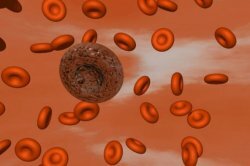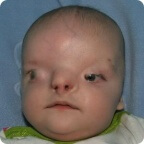Von Willebrand's disease
 Von Willebrand disease is a genetic blood disease characterized by episodic spontaneous bleeding, similar to bleeding in hemophilia. Type of inheritance is autosomal dominant. Acquired form of this disease is extremely rare.
Von Willebrand disease is a genetic blood disease characterized by episodic spontaneous bleeding, similar to bleeding in hemophilia. Type of inheritance is autosomal dominant. Acquired form of this disease is extremely rare.
In healthy people, in case of bleeding, platelets( small blood plates) are immediately sent to the newly opened bleeding focus and are glued together to stop it. If a person has Willebrand disease, the blood, due to lack or lack of a special protein in it, loses the function of normal clotting. This protein is called von Willebrand factor, due to which the blood can fold
Causes of vWF disease
Von Willebrand disease is most often transmitted autosomal dominant way, in other words it is a hereditary disease and is the most common form of congenital blood clotting disorders. Most often the disease is mild and equally affects both women and men. The prevalence of the disease is one case per thousand people.
Types of VW disease
There are three types of this disease:
1 Type. In this case, the disease is associated with the loss of von Willebrand factor, which is the cause of moderate and weak bleeding in its severity. The severity of bleeding directly depends on exactly what amount of protein was lost. About 75% of patients have exactly one type of disease, in which treatment is often not required.
2 Type. This type occurs in the case of inactivity or inadequate activity of von Willebrand factor in its presence in the blood, which is the cause of moderate or weak bleeding in its severity.
3 Type. This is the most common type of this disease, characterized by a complete absence or very small amount of von Willebrand factor, which causes very serious bleeding. In this type of disease, people can develop very dangerous bleeding and anemia after surgery or trauma.
Von Willebrand's disease may both worsen with time and stay at the same level
Symptoms of vWF disease
The main symptoms of this disease are extensive bleeding, the severity of which varies from person to person. The severity of the hemorrhagic syndrome varies from extremely mild forms, with occasional small subcutaneous hemorrhages and nasal bleeding, to extremely severe very dangerous variants with long, very frequent, profuse bleeding of various locations, the formation of large hemorrhages and hematomas in the internal organs and soft tissues. Sometimes there may be hemorrhages in the joints.
Symptoms of a mild form of the disease: bleeding gums, frequent nasal bleeding, severe blood loss during menstruation, heavy bleeding after surgery or trauma, the appearance of no visible bruises.
Symptoms of more serious forms include, besides all of the above, the following: the appearance in the urine of blood admixture( hematuria), even after minor bruises appear bruises, stools of bloody or dark tarry;There are intra-articular bleedings( a rare symptom), causing swelling, difficulty in movement and pain. The most severe are uterine and gastrointestinal hemorrhages
Diagnosis of vWF disease
In the diagnosis of this disease, certain difficulties may arise, With mild forms of the disease, bleeding is not discovered more often than in completely healthy people. Usually, in such cases, the person does not notice anything until the sudden sudden bleeding develops after surgery, trauma, or during a visit to the dentist.
If a person suspects poor blood coagulation, the doctor should find out how often bleeding is observed and how strong they are. If he has a suspicion of Willebrand disease, the following tests are assigned: genetic testing( helps to establish the presence of abnormalities in the structure of von Willebrand factor), measures the clotting time of the blood, analyzes for detecting the activity of von Willebrand factor or analysis of its activity level. The most informative is the quantitative determination in the patient's plasma of f.
Treatment of von Willebrand disease
Treatment of this disease depends on its type, the frequency of bleeding and the likelihood of severe bleeding.
For the diagnosed mild form of von Willebrand disease, the following recommendations should be observed:
- During the birth, surgery and trauma, the recommended
medications should be taken to prevent bleeding. - Use non-steroidal anti-inflammatory drugs such as Ibuprofen and Aspirin
- If possible, avoidreception of antiplatelet agents( clopidoral and so on) and anticoagulant medications( Heparin, Warfarin, etc.)
When diagnosedA severe form of von Willebrand disease is strictly prohibited from taking anticoagulant drugs. In this form, the following treatment methods are used:
- Substitution therapy with drugs containing von Willebrand factor
- To promote the cessation of bleeding, a drug such as Desmopressin
is indicated. - To stop bleeding, such preparations as thrombin powder or fibrin glue
are applied to the woundsevere von Willebrand disease with the goal of preventing and eliminating bleeding should be followed by increased precautions. To prevent hemorrhages in the joints and muscles should be an active lifestyle + maintain a normal body weight. However, contact sports( football, hockey, martial arts, etc.) should be avoided, during which lessons there is a high risk of injury.
Prophylaxis and treatment of von Willebrand disease at home
First of all, you should avoid taking abnormal blood clotting processes and increasing the risk of intestinal and gastric bleeding medications, which include:
- Drugs containing salicylates( analogues of Aspirin) thatare part of most cough medicines, as well as drugs such as Pepto-Bismol and Alka-Seltzer
- Such common non-steroidal anti-inflammatory drugsnaproxen, ibuprofen and aspirin
In the case of poor blood coagulation as an analgesic, it is most safe to take acetaminophen( Tylenol, etc.), under the influence of which the probability of occurrence of gastrointestinal bleeding is significantly reduced. People with Willebrand disease should avoid taking antiplatelet( Clopidogrel, etc.) and anticoagulants( Heparin, Warfarin) drugs.
Recommendations for a severe form of von Willebrand's disease are as follows:
- It is mandatory to maintain adequate body weight( obesity increases the load of joints at times, thus contributing to bleeding)
- For weight control, maintaining muscle flexibility, preventing joint damageand muscles, it is necessary to lead an active lifestyle
- The patient should learn to recognize the bleeding started by secondary signs, due to which, over time, a person can be infallibleInternal recognition of joint or muscle hemorrhage
- It is necessary to learn how to make yourself and / or your child an injection of von Willebrand factor. Children over the age of ten can already begin to be taught to help themselves, as the ability to make an injection in the shortest time helps to avoid complications and significantly speeds up treatment.



